Abstract
A new adaptive dynamic multi-grid method is developed for simulation on evolving damage in concrete column under seismic loading. The method should possess adaptive capability in order to carry out automatically coupling analysis without user intervention in the computation. As a case study of the method, the process of evolving damage to failure of a concrete column under seismic loading is simulated, and the simulated results fit well with the experiment. It shows that, the developed method can be used to reveal the seismic failure mechanism of concrete structures by considering the dynamic coupling process from material damage in concrete of stress concentration zone to local failure in vulnerable component and eventually to structural failure with the adaptive capability as well as better computational efficiency.
1. Introduction
The failure of the engineering structures due to earthquake will inevitably lead to disaster results. So the study on seismic damage and failure mechanism of engineering structures has attracted the attention of researchers and engineers, especially for concrete structures which are widely used in civil engineering structures due to its good qualities and low cost. Many works have been done on the seismic analysis of engineering structures. Zhou studied the nonlinear dynamic seismic responses of the large-span RC frame structures [1]. Yan investigated the seismic performance of rigid frame bridges using the numerical method [2]. Scotta proposed two series of indexes, which respectively are Global Damage Indexes (GDIs) and Section Damage Indexes (SDIs). They are respectively to evaluate seismic performance of overall structure and RC beam-column sections [3]. Ghobarah proposed a method for damage assessment of structures under seismic loading based on the change in stiffness of the structure, which is better suited for non-linear structural analysis [4].
In reality, the seismic damage and failure of concrete structures appears as an irreversible process from material damage in concrete of stress concentration zone to local failure in vulnerable component and eventually to structural failure. But the few previous methods can describe the trans-scale process.
Therefore, a new adaptive multi-grid method is developed to simulate the process from material damage evolution to failure of concrete structures with lower cost for better understanding the seismic failure mechanisms of concrete structures.
2. Strategy for the adaptive multi-grid method
2.1. Description on concrete damage evolution in the method
In the method, the degradation of the properties of material is described using a damage variable based on the concept of continuum damage mechanics (CDM). Here famous Mazars damage model is adopted and coupled in the method to describe concrete damage evolution. And the model can be written as [5]:
where is the strain threshold of damage, , are model parameters, (, is the principal strain).
2.2. Adaptive grid-change criteria
In the developed method, the elements can adaptively be refined based on damage state of the element. In order to achieve this, adaptive grid-change criteria is coupled in the method, as shown in Fig. 1.
Fig. 1Adaptive grid-change criteria
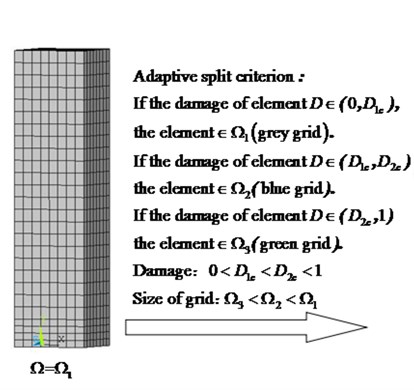
a) Initial FE model consists only of coarse grid
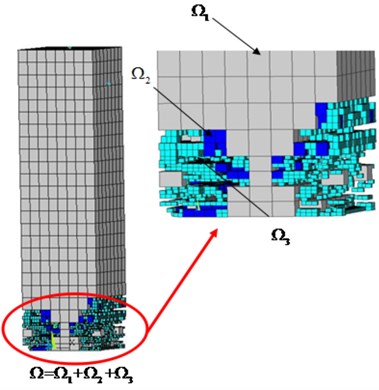
b) FE model consists of multi-grid
2.3. Flow chart of the developed method
The flow chart of the method is given in Fig. 2. Using the developed adaptive multi-grid method, the process from evolving material damage to structural failure can be described. And FE elements can be refined to smaller scales adaptively due to accumulation of damage for better effective.
3. Dynamic simulation on seismic damage evolution of a concrete column and experimental verification
In order to study the seismic failure mechanism of concrete structures, collapse experiments of concrete columns under cyclic loading were carried out by Tsinghua University [6]. As a case study of the method, the dynamic damage evolution of the concrete column under seismic loading is simulated under the specified experiment condition and compared with experiment, as shown in Fig. 3. The results of simulation agree well with the experimental results, which imply that the method is reliable in simulation on dynamic evolving seismic damage and failure in concrete structures.
Fig. 2Flow chart of the adaptive multi-grid FEM
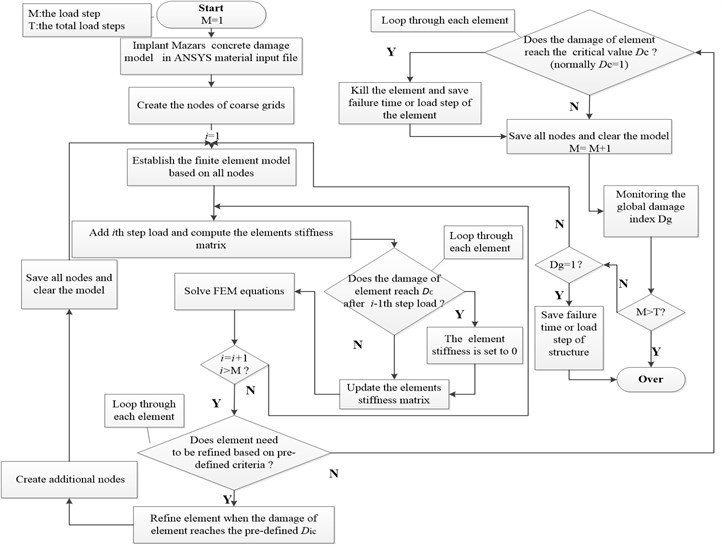
Fig. 3Comparison between calculation and experimental results
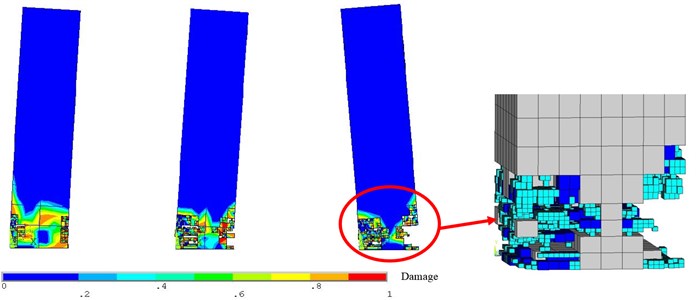
a) Calculation result at the cycle ratio
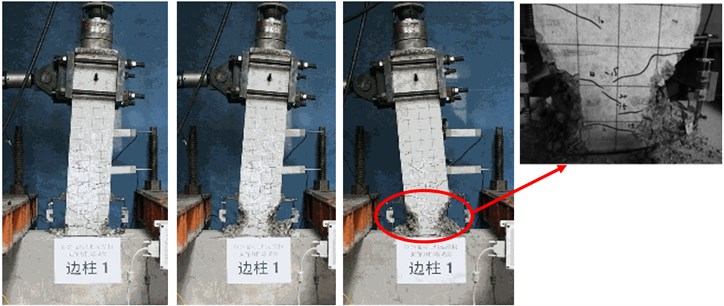
b) Experimental result at the cycle ratio
4. Conclusions
1) A new multi-grid method is developed for simulating the dynamic process from damage evolution up to failure in concrete structures under seismic loading.
2) Another feature of the proposed multi-grid FEM method is that the FE elements can be refined adaptively due to damage accumulation. The adaptive capability enables the mesh of the computational domain to be refined automatically more precisely while the damage in the area is more severe, without user intervention.
3) The developed method has been successfully applied to simulate the dynamic seismic damage process of a concrete column. And the simulated results fit well with the experiment.
References
-
Zhou J., Mao W., Cai J. Earthquake response of large-span reinforced concrete structures with haunch braces under vertical ground motions. Journal of Vibroengineering, Vol. 17, Issue 2, 2015, p. 776-791.
-
Yan B., Xia Y., Du X. L. Numerical investigation on seismic performance of base-isolation for Rigid Frame Bridges. Journal of Vibroengineering, Vol. 15, Issue 1, 2013, p. 395-405.
-
Scotta R., Tesser L., Vitaliani R., Saetta A. Global damage indexes for the seismic performance assessment of RC structures. Earthquake Engineering and Structural Dynamics, Vol. 38, Issue 8, 2009, p. 1027-1049.
-
Ghobarah A., Elfath H. A., Biddah A. Response-based damage assessment of structures. Earthquake Engineering and Structural Dynamic, Vol. 28, 1999, p. 79-104.
-
Mazars J., Pyaudier-Cabot G. Continuous damage theory – application to concrete. Journal of Engineering Mechanics, Vol. 115, Issue 2, 1989, p. 345-365.
-
Lu X. Z., Ye L. P., Pan P., Tang D. Y., Qian J. R. Pseudo-static collapse experiments and numerical prediction competition of RC Frame structure II: key elements experiment. Building Structure, Vol. 42, Issue 11, 2012, p. 23-26, (in Chinese).
About this article
The work described in this paper was substantially supported by the Scientific Research Foundation of Graduate School of Southeast University (No. YBJJ1440), National Natural Science Foundation of China (No. 11072060) and Jiangsu Higher Education Institutions for the Priority Academic Development Program, which are gratefully acknowledged.
